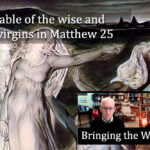The lectionary gospel reading for the third Sunday before Advent at the end of Year A is Matt 25.1–13, known as the parable of the wise and foolish virgins. This forms part of the second half of Jesus’ teaching about the future. In Matt 24.3, in response to Jesus’ prediction of the destruction of the temple, his disciples have asked him a two-part question:
“Tell us,” they said, “when will this happen, and what will be the sign of your coming and of the end of the age?”
In response, Jesus answers the first question (‘When will this happen?’) in Matt 24.4–25, and then changes to answer the second question (‘What will be the sign of your coming and of the end of the age?’) from Matt 24.36 (‘But concerning that day and hour…’) through to the end of chapter 25. Once again, the chapter divisions mislead us by putting the break in the wrong place. Jesus does indeed give the disciples plenty of information about the ‘signs’ that will accompany the fall of Jerusalem, and what they are to do in response to these events which will happen ‘before this generation passes away’ (Matt 24.34). But from Matt 24.36 onwards, there is a complete absence of signs; the parousia of the Son of Man will happen without warning, and so the repeated emphasis is on continual readiness, rather than on looking out for signs.
Throughout this whole long section Jesus deliberately refuses to give the disciples the sign they have asked for. The timing of the parousia and the final judgement cannot be calculated and foreseen. Readiness for those climactic events can be achieved only by living all the time in such a way that their unannounced arrival need not be a disaster but rather a time of praise and reward for a life well lived and opportunities well taken (R T France NICNT p 936).
Within this section, we have an introduction and a conclusion, and within that (yes, you guessed it!) three parables:
- The suddenness of the parousia compared with Noah’s flood
- The parable of the slave left in charge
- The parable of the girls waiting for the bridegroom (‘the wise and foolish virgins’)
- The parable of the slaves entrusted with money (‘the parable of the talents‘)
- The final judgement by the Son of Man now enthroned
The final episode, often called the ‘parable of the sheep and the goats‘ is not actually a parable; the simile of a farmer dividing the sheep and goats is only mentioned in one verse, and otherwise this is a simple, visual description.
Much of this material, and its distinctive structuring, is unique to Matthew. Some of it appears in Luke 12 and 17, whilst variations of the ‘parable of the talents’ does come in the Olivet Discourse in Mark 13 and Luke 19. But many of the themes are characteristic of Matthew’s depiction of Jesus. The parable has been very popular in church art and sculpture, and it was the subject of one of the earliest of theological treatises, that by Methodius (bother of Cyril), on The Banquet of the Ten Virgins which includes one of our earliest written commentaries on the Book of Revelation. Some have claimed that, with its motif of delay of the parousia, this must be a creation of the early church, but the belief that the delay was a crisis requiring a response is solely based on texts like this, so this argument is entirely circular.
Kenneth Bailey, in Jesus Through Mediterranean Eyes p 270, observes a seven-point symmetrical structure to this parable, in which it is the coming of the bridegroom that forms the central turning point:
He also notes some key elements that make sense of the story within its culture. Weddings would normally take place in the seven months of the hot and cloudless summer, and so the celebrations would take place in the cool of the evening and into the night. The bridegroom would leave the celebration party at his own house, and journey through the village to collect his bride, whilst the party remained outside the house awaiting his arrival. The bride would then be placed on the back of an animal, and the groom would lead her back through the village, taking the longest route possible through all the streets so that the whole town could see and join in the celebration. The exact time of the return would therefore be unknown, and could be longer than expected.
In contrast with this background, there is no obvious role for the ten young women, and the various speculations of commentators on their role in the celebrations is fruitless—we simply don’t have enough detail about the ceremonies of the time to know. Although the word parthenos is used to describe them, nothing is made of their virginity as such; the term would be understood simply to imply that they were young enough not to have been married yet. And, of course, they are not the bride! This is a parable, not an allegory, and we need not press each detail into the theological shape of other parts of the NT where the bride for the groom represents the people of God.
The parable begins with the comparison formula we have already seen in Matt 13.24, 18.23, and 22.2, ‘the kingdom of heaven is like…’ but in this case, since it is looking ahead to The End, we now have the future tense ‘The kingdom of heaven will be like…’ As in previous parables in this gospel, the comparison is made directly with (a person of) a group of people—though we might more naturally make the comparison with the situation.
The previous parable had as its central character a male slave; by contrast we have here women providing the example for understanding the kingdom. Matthew does not have quite the same deliberate pairing of male and female in both the narrative and teaching of Jesus, but it is clear that women remain models of discipleship and positive examples in the teaching of Jesus. The number ‘ten’ might allude to the ten men required to form a synagogue, but it is also a natural, round number, and in the telling of the parable it is then easy to use the five fingers of each hand to illustrate the two groups.
The word translated ‘lamp’ in most ETs is lampas which actually means ‘torch’ for use outdoors, formed from a bundle of sticks which is then dipped in oil, rather than the pottery lamps with a wick which are called luchnos. These are the torches born by the arresting party in John 18.3 and the torches around the throne signifying the Spirit in Rev 4.5. This fits perfectly with the situation of the parable, with the girls (along with the rest of the party) waiting outside, though most illustrations, including that by Blake above (and Bailey’s commentary, surprisingly) mistaking the one for the other. Unlike, lamps, which have a reservoir and so can burn for some time, torches go out quickly and need to be dipped in oil repeatedly to maintain their light. ‘A torch without a jar of oil was as useless as a modern flashlight without a battery’ (France, p 949).
The distinction between the ‘wise’ and the ‘foolish’ was made at the beginning of Jesus’ teaching in Matthew, with reference to the two builders, the wise one building on the rock of obedience to Jesus’ teaching and the foolish one building on the sand of ignoring what he said in Matt 7.24f. The wisdom commended here is phronesis rather then sophia, practical wisdom that involves good judgement as well as sound character and habits, rather than abstract or speculative wisdom acquired by reflection. It was also the hallmark of the faithful slave in the preceding parable. The term for ‘foolish’, moros, has given us our term ‘moron’; the contrast between the wise and foolish is a frequent feature of the wisdom literature of the Old Testament, especially in Proverbs, highlighting different practical approaches and choices in lifestyle.
The image of the bridegroom at the wedding was used earlier, in Jesus’ Galilee ministry, in relation to the question of fasting (Matt 9.15) where Jesus clearly depicts this as a reference to himself. This nuptial imagery is developed theologically in John 3.29, and most extensively in Rev 21.2, 9 and 22.17, where the people of God as the holy city become the bride of the lamb. However, not all the details are developed in this way in this parable.
Earlier in this section, staying awake has been the primary metaphor for alert readiness for the coming of the Son of Man (Matt 24.42), but here the metaphor is changed. Both the wise and the foolish fall asleep and need to be roused, but the wise have made provision so that their lamps are ready. The conclusion to the parable, ‘Stay awake (gregoreo) therefore, for you know neither the day or the hour’ sits uneasily with the preceding narrative, so should perhaps be read as a conclusion to the earlier teaching rather than this parable in particular.
It would not be difficult, within a first-century village, quickly to borrow some oil from a neighbour, and the closing of the door, shutting out the foolish, is not based on any actual practice that we know of. As with other parables, the details of the real-life illustration have been adapted to fit the point that Jesus wants to make in his teaching.
In a parable things do not always happen according to real life, and the hard-nosed realism of the sensible girls invites the reader to reflect that spiritual preparedness is not something that others can provide for you: each needs their own oil (R T France, NICNT, p 949).
The conclusion of the story blends the narrative itself into the teaching of Jesus, so that the bridegroom transitions to become the person of Jesus himself. The appeal of the five foolish girls, ‘Lord, lord…’ reminds us of the appeal of those who ‘prophesied in your name’ in Matt 7.22, as does Jesus’ reply, introduced as a solemn ‘Amen…’ saying ‘I do not know you’.
But this has become, like so many of the other parables, a story of insiders and outsiders, of the saved and the lost, and the closing of the door symbolises that final division of the last judgement, as we have seen it in [other passages] (France, p 950).
For all who are committed to the host of the banquet, the door to the banquet is open. But near the end of the parable that door is closed. Jesus’ parable places limits to the Roman sacred cow of inclusiveness that wandered the streets of Rome and now traverses the byways of contemporary western culture (Bailey p 275).
There are two final issues to consider. First, what, if anything, do the lamps and their oil signify? Dick France is sceptical of any specific reference, other than the whole episode signifying the need to be in a state of constant readiness, and there do not appear to be many clues in the passage itself. But the importance of oil in anointing in the OT, signifying the calling and equipping of God, and the image of tongues of fire at Pentecost and torches in Rev 4.5 makes it hard not to associate the torches and their light here with the Spirit—though explicit mention of the Spirit is not a feature of this gospel. Matthew’s repeated emphasis is on discipleship expressing itself in practical action, so I would link the Spirit with the life of holiness as Paul does in Gal 5.22. And the focus at the end is on filial relationship with the bridegroom (‘I do not know you’; compare Matt 12.50 where Jesus’ disciples are his family) so I would also want to link the Spirit to the relational knowledge of God as Paul does in Romans 8.
The second concluding question is whether this parable is about judgement or grace. The rhetorical punch of the close and climax of the parable is, as France points out, the division and exclusion created by the closing of the door, and the emotion of this is captured well by Blake (so we can perhaps forgive the use of the wrong kind of lamp!). Yet the context of the whole story is the certainty of the coming of the bridegroom, and the feast to which all ten girls have been invited. This invitation, as much as the possibility of its loss, should surely be a vital part of the motivation to ‘stay awake’, constantly open to the daily renewing of the Spirit in both bringing life to our relationship with God and shaping our lives in holy obedience.
Give me oil in my lamp/torch, keep me burning. Keep me burning till the break of day…
Come and join James and Ian as they discuss the issues here and the implications for reading and preaching:






























Ian, you write:
And then:
How to reconcile the two?
The love of God and neighbour is the determining theme in Matthew’s Gospel. Our Lord is warning us us that it is possible to risk loss of entry to God’s presence even after we have been regenerated through the Holy Spirit; a sobering and humbling meditation, that we could hear those dreadful words, “I know you not.”
We ready ourselves by the practice of a Christian life; the habitual and frequent use of the means of grace and by daily reflection, repentance and amendment. Worship, confession, prayer and spiritual readings that express our love of God; and acts that reflect our love of our neighbour. These together put the “oil” in our lamps to greet the Bridegroom when He comes. Do this and, through grace, we become “wise virgins;” our lamps are replenished. We may need this repeat this repentance over and over. This perseverance is final grace we seek when we “fall asleep” spiritually.
The “ten virgins” (referred to as “maidens” in HJ’s all boys school) are often understood to represent disciples of Jesus the Bridegroom. “These five and five virgins are all Christian souls together”, says St Augustine; they are souls who “have the Catholic faith and seem to have good works in the church of God.” The “oil” signifies good works, a connection made by Jesus between the lamp that shines before men and good works; let your light shine before others, that they may see your good deeds and glorify your Father in heaven.”(Matt 5:15-16)
Children often say it was mean of the other maidens to refuse to share! But there is no contradiction here because our spiritual exercises and good works are nothing without love (1 Cor 13:1-3). The wise virgins couldn’t give their oil to the foolish virgins because no one can borrow the good works of others to make up for the good works they’ve failed to do. Each person must, as Paul writes, “work out [their] own salvation with fear and trembling.” (Phil 2:12)
St. John of the Cross says: “At the evening of life, we shall be judged on our love.” Because the five wise virgins were perfected in good works and charity, they were “ready” and “went into the wedding feast with him.” And then the door was locked, echoing Jesus’ earlier statement from the Sermon on the Mount: “Not every one who says to me, ‘Lord, Lord,’ shall enter the kingdom of heaven, but he who does the will of my Father who is in heaven.” (Matt 7:21)
I wonder what Jesus presentation looked like when He told this parable? Imagine it like someone signing for the deaf. Jesus starts by holding up both hands and proceeds to sign with them like glove puppets. The left hand implores the right hand. The hands close together in sleep. The right hand dismisses the left behind His back. The right hand greets the groom. etc.
I like to imagine His first audience wrapt up in the sleight of hand as he conjures before them.
Mat 6:3
Don’t let your left hand know what your right hand is doing
If I remember rightly, Kenneth Bailey considers that a story / parable like this invites comeback. Within the story, in that culture, the five who are left out would not just accept being shut out without debate, and the crowd hearing the story would want it to continue – it is not yet resolved. Bailey writes his commentaries from recent and extensive knowledge of Middle Eastern culture, and does not see this as a story which ends with the last full-stop. Such an approach opens up possibilities and asks questions, expecting the hearer to be active in participation not just a passive receiver of a story.
Well yes, that is true. But I am not sure that the parable ends ambiguously—unlike, for example, the story of the two sons and loving father.
The door is shut.
The question is: how will the listeners respond to it…?
Matthew 11:17
“‘We played the pipe for you, and you did not dance; we sang a dirge, and you did not mourn.
I wonder if the parable of the foolish virgins Jesus told was actually a ‘playground’ activity or role play that boys and girls took part in. All knew how to play it and what the rules were. Sort of “what’s the time mr wolf” .
@ Steve
Unlikely!
In Matthew 11:17 Jesus is making the point that the Jews rejected John’s message of judgment (expressed by not eating and drinking) and Jesus’ message of joy and hope (expressed by eating and drinking) because John and Jesus did not fit their expectations of Elijah and the Messiah.
HJ, I was unclear; Jesus was alluding to games children play, was He not. So perhaps Jesus used a commonly understood children’s roll playing game to illustrate a deeper reality.
Did it not fit their expectations because of the OT writings, or just their understanding of them? James Tabor, who is a liberal scholar, would argue many of the messianic passages in the OT do not seem to be reflected in Jesus.
I appreciate that this is not an allegory, but I feel this interpretation makes the parable a bit rubbish?
Why – in the parable – are the five virgins punished? Not for falling asleep – all ten fell asleep, as you said – but because nobody would share with them the oil. You can say that good works or the Spirit or faith can’t be given (but then you’re allegorising) but then wouldn’t Jesus have come up with something that maintained that unsharable property.
I am inclined to read it as the wise virgins -reasonably enough – will not share for fearing of running out since they want to go to the party (and who knows when the Bridegroom will arrive) and that nobody in the crowd has oil, but perhaps is willing to share or sell some of the store elsewhere (and not far elsewhere) but in that very short amount of time the Bridegroom has come and entered and the doors are shut.
I wonder too if all ten going asleep is part of the reason – in the parable – that they’ve no idea when he’ll arrive. They – not we for that matter – know for how long they’ve slept.
The story is in a series of stories about someone coming at a time which is not expected or predictable (no ‘sign’). To use Bailey’s word, the dim-witted young women made no allowance for the bridegroom coming later than they expected. If the thoughtful young women had shared their oil, then none of them would have had enough.
When the Bridegroom returns, it will be too late to get yourself sorted out.
“. If the thoughtful young women had shared their oil, then none of them would have had enough.”
I don’t think that statement being true is implied or said in the story. The Bridegroom arrives while the foolish virgins are away trying to get oil, assuming that they leave pretty sharpish and it doesn’t take that long, and that the Bridegroom could have taken a very long time then they couldn’t have been that wise if they didn’t have more than twice as much oil as they actually end up needing.
I don’t think that statement being true is implied or said in the story.
Er, verse 9:
But the wise answered, saying, ‘Since there will not be enough for us and for you, go rather to the dealers and buy for yourselves.’ (ESV)
The NIV says “there may not be enough for both us and you.” and the Authorised says ” Not so; lest there be not enough for us and you:”
This all feels a bit speculative to me, it seems obvious that the key parts of this are readinessand the possession of oil and thus light.
Oil in the bible has often been regarded as symbolic of The Holy Spirit; “The Spirit of the Lord is upon me, for He has anointed me to bring Good News to the poor.
“The oil-filled lamps are symbolic of the Holy Spirit which lights the way before the saints”.
McConkie (1915–85)
The Holy Spirit is given to us for the purpose of when he comes
“He will convince the world of sin, and of righteousness, and of judgment: We do well to hear what the Spirit says to the Church.
We are exhorted to be continually be being filled with the Holy Spirit.
Much like the prayer of the Psalmist [O Lord] “ send forth thy light and thy truth let them lead me to thy Holy Hill and to thy Holy Tabernacles.[The place of His and our rest]
Alan,
If we are to be continually filled (in the context of oil in this parable) we would be away looking for a merchant to buy oil and thus not on sentry duty. 🙂
Perhaps that sums up the modern Christian—always reading theology, discussing theology, looking for interesting, uplifting sermons on-line.
One more random thought, then I’ll stop, promise.
Remember that advert about a photographer waiting outside the panda enclosure in a zoo?
He takes a break, eats a Kitkat, then resumes his vigil. While he takes a break two pandas skate out of their cave, do a dance routine and return.
Nobody seriously asks: ‘what happened to the photographer, did he eventually get a shot? How long does a break have to be to qualify for a Kitkat? Etc..
Steve, you mean we’ve missed it? Oops.
Ian, you asked about a song. Wachet auf (Sleepers wake) written by P Nicolai (1556-1608). Will be sung in some churches in Advent.
Thank you!